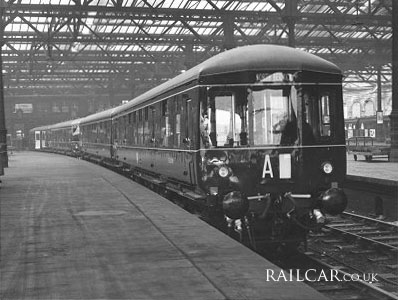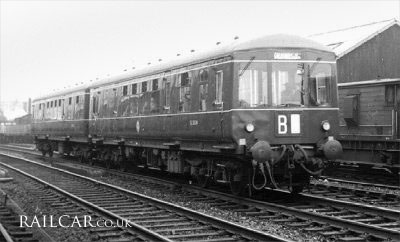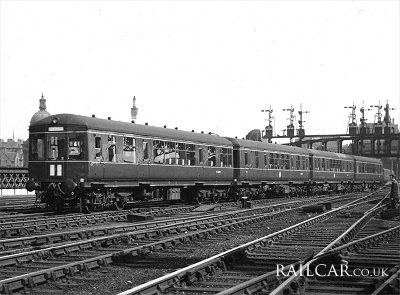Class 100 Gloucester RC&W 2-car DMUs
Operations - Scotland
Noted heading north through Preston towards Edinburgh on 17/12/57 were 51117 / 56309, on the 19th 51118 / 56310, and 51119 / 56311 one week later on the 24th.
The introduction to the Edinburgh District local services was postponed from the 6/1/58 to the 3/2/58 on the Corstorphine - North Berwick and Waverley - Galashiels (via Peebles) services. The Princes St - Leith service was also postponed from the 6th January to a later date. The ScR ran a special newspaper advertising campaign for the introduction.
The ScR PR department issued an illustrated brochure "Introducing the new Diesel Railcars Edinburgh Suburban Service" to introduce the new diesel railcars to the public. It included a series of diagramatic maps outlining the five Edinburgh suburban lines over which the new sets would progressively run when delivered and placed in service, as well as mentioning some features of them such as the power units, heating arrangements and views from the windows!
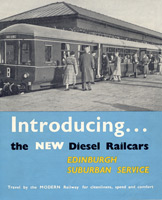
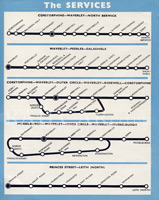
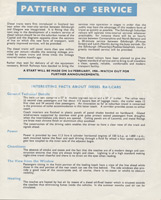
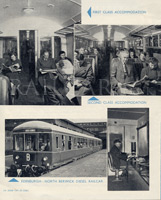
Pre-launch display
A new GRC&W twin DMU was in Edinburgh Waverley for a press/management inspection and test run to Drem and back on the morning of Tuesday 28th January 1958. It was attended by Sir Ian Bolton, British Transport Commission chairman, members of the Scottish Area Board, and James Ness, General Manager of the ScR.
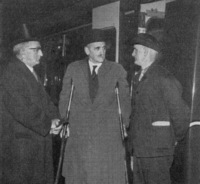
Left to right: Edinburgh Waverley Station Master T.D. Arnott, British Transport Commission Chairman Sir Ian Bolton, and Driver Lister. They are outside the cab of the DMU.
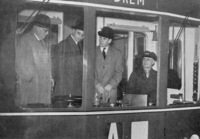
In the driver's compartment are Scottish Region General Manager James Ness, Viscount Elibank, Bailie R.D. Hunter and Driver Lister. This was prior to the demonstration run.
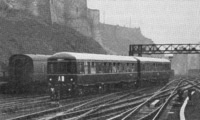
The DMU at Edinburgh Waverley on completion of a demonstration run to Drem and back for officials and press.
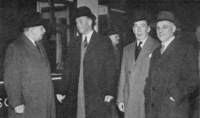
After the test run are, left to right, Motive Power Superintendent Mr C. Ross Campbell, Mr D.H. Cameron of Lochiel, Mr Peter Meldrum, and Mr F. Donachy, Members of the Scottish Area Board.
On the afternoon of the same day two of the sets were put on public exhibition.


In the image young railway enthusiasts fill the cab of one of the units during the public exhibition.
The final photograph was taken the day following the exhibition, the 29th January.
The Edinburgh sets were to provide a more frequent service, particularly during peak hours, and were expected to cover a total of 1,000,000 miles a year, double that provided by the steam trains they replaced.
Services Begin
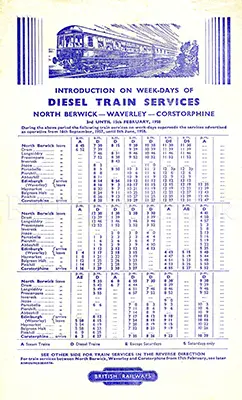
Corstorphine - North Berwick
From 3/2/58 they began an hourly service between Corstorphine and North Berwick (which had Edinburgh Waverley as an intermediate stop), at the 30min past the hour from North Berwick from 07:30 to 21:30 (except 08:15, 16:41, 17:33 and 18:35). In the reverse direction departures from Corstorphine were mainly at 10 or 15 mins past the hour, but from Waverley at a more uniformly 30 mins past. On most services timings were accelerated.
Pictured is the handbill containing the timetable issued for the introduction — it covered a period of just two weeks! Scan courtesy of John Horne.
A few days after the services began, on the 8th Feb., a set was stranded on the North Berwick branch due to snow drifts, resulting in buses being used between Longniddry and North Berwick.
Edinburgh to Galashiels
From 17/2/58 they were introduced on services from Edinburgh to Galashiels via Peebles East, on a considerably expanded timetable. New trains left Waverley at 09:10, 12:20, 16:21 and 18:26, and the previously Saturday Only 20:50 was changed to 20:45 and run daily (previously the last Monday to Friday train had been the 17:05). In the reverse direction there was new trains from Galashiels at 11:15, 14:06, 18:05 and 20:35, while the 10:16 was changed to 10:00, and the weekdays 19:15 and SO 13:15 were withdrawn.
The image shows Sc51124 leading a 2-car set on the 12:20 Edinburgh - Galashiels past St. Margarets on the 7th April 1958. Hamish Stevenson.
Other routes
As soon as further sets were available they were introduced on services from Corstorphine to Rosewell, and both Corstorphine to Corstorphine and Musselburgh to Musselburgh both via Craiglockhart and Newington, which took the southern loop between Gorgre and Portobello via Morningside Road as well as the main line through Waverley. These services required a reversal at Portobello after leaving, or in the reverse direction, to gain the Circle Line.
On the 25th February 1958 50342/56097 were noted on driver instruction work on the Kelvin Valley branch. For this the set came through from Leith Central on Monday mornings and was stabled at Eastfield until the following Friday night.
From the 5th May 1958 they were introduced on Edinburgh Princes Street to Leith North services. The Monday to Saturday only service ran from 7am to 7pm and again gave a considerable increase trains, with 27 each way compared with 15 Monday - Friday and 7 on Saturdayss (previously there were no trains after 2pm on Saturdays).
They were also used to Melrose and Hawick, and on locals to Polmont.
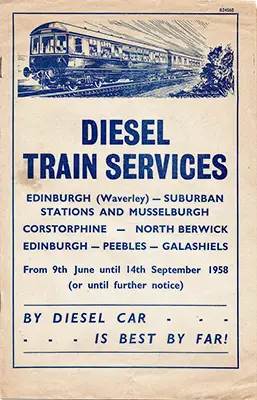
The 9th June saw the completion of the Edinburgh Suburban Dieselisation Scheme when sets took over the suburban and the Musselburgh services. The service was basically the same as steam - the journey times on the suburban was actually slightly increase, to allow for engineering work in connection with the new Craiglockhart - Slateford line. The Edinburgh - Rosewell and Hawthornden trains were also dieselised and improved.
A selection of handbills from the early years of the suburban services can be found here.
Edinburgh (Princes Street) to Glasgow (Central)
On Monday 7th July (although I've also seen this date quoted as the 4th August) they took over the Edinburgh (Princes St.) to Glasgow (Central) services, operating as four car sets, with steam remaining on the 12:30 SO, 13:20 SO and 17:16 SX from Central, and the 17:17 SX, 18:10 SO and 22:45 SO from Princes Street. While at the termini the sets also worked the following trains: 06:45 Shotts - Edinburgh, 18:10 SO Edinburgh - Shotts & 20:58 SO return, 12:33 Edinburgh - Kingsknowe and 13:06 SX return, 07:30 and 15:30 Cathcart Outer circle trains, and the 13:25 Glasgow - Whitecraigs and 14:27 return.
The image is a ScR publicity shot of a set leaving Glasgow Central, dated 10th July 1958.
On the 2nd August 1958 a combination of the Bank Holiday and the return Glasgow Fair traffic saw an 8-car set used to supplement the Swindon Inter-City sets on the Edinburgh - Glasgow line.
It wasn't long before the ScR cars were joined by eleven of the LMR sets, some going to Hamilton, although two returned south soon after.
It was noted in September 1958 that the DMUs had not stimulated any extra passengers on the Princes Street - Central line. Most services were now reduced from 4-cars to one twin, and Met-Camms were also appearing on the services. On the 15th Sep. '58, the Edinburgh Autumn Holiday, the North Berwick services were 'jam-packed' and extra steam services were run.
Apparently due to complaints of rough riding in late 1958, the sets were taken off the Edinburgh Princes Street - Glasgow Central via Benhar line for a spell, and replaced by Swindon Inter-City sets and 101s from Dundee. When the Swindon Inter-City sets were transferred from the WR to the ScR, these replaced any Gloucester workings still remaining on the Edinburgh / Glasgow via Holytown line.
Around March 1959 the ScR formed a 3-car set for use as a test train on some routes, loaded with brake blocks.
On Sunday 9/8/59 a diesel land cruise from St. Enoch to Largs and Girvan consisted of four Gloucester twins. Similar recent excursions had used Met-Cams.
Failures requiring assistance were becoming more and more frequent on the Edinburgh suburban line in Winter 1959/60, not helped by the increase in traffic. N15 69211 from 64B was a regular in assisting ailing units.
1960s
About November 1960 the BMU was absent from the Ballater line, and its workings were being operated by a Gloucester or Cravens unit. Sets were on loan from Leith to Kittybrewster for this, first 50340/56095 (November 1960 to March 1961) then 50342-56097 (March 1961 to April 1961).
Many of the Edinburgh routes - to Peebles / Galashiels, the inner and outer suburban circles and Leith North lines, closed in February 1962 allowing twelve sets move to the Glasgow area by the end of the year to Hamilton and Corkerhill. They happened to be the twelve lowest numbered vehicles, 50339-47 and 51108-10 with partners.

In the image the Stonehouse signalman waits to collect the token from the driver of the incoming GRCW twin on a service from Strathaven on the 2nd October 1965, the last day of services. Hamish Stevenson Collection.
Services to Coalburn ended in October 1965, a YouTube feature on the branch has clips of GRC&W sets including Sc50343.
1965 allocations were:
50339-43 with 56094-8 at 66C (Hamilton) for South Clyde locals from Glasgow Central & Hamilton.
50344-7 with 56090-102 and 51108-10 with 56300 were at 67A (Corkerhill) for Glasgow St. Enoch - East Kilbride / Kilmacolm workings.
51111-27 with 56303-19 were allocated to 64H (Leith Central) for Edinburgh - North Berwick workings.
The first vehicle to be withdrawn was Sc56304 from Hamilton in March 1966, reason unknown.
April 1966 saw almost every Class 100 vehicle (ScR and LMR) change depots. The major changes in Scotland were the first batch sets moving back east to Leith Central, the remaining second batch sets in Edinburgh moving west to Hamilton / Corkerhill. They would help with the elimination of steam in the Glasgow area.
Set numbers were introduced to the Scottish Region in 1966, beginning with the Glasgow area in June. The ten sets at Corkerhill (51108-11 and 51113-8) were numbered 11-20 and the nine sets at Hamilton (51119-27) became 21-29. When introduced to the Edinburgh Division in November, the list showed that Leith Central had eleven sets which were allocated numbers 75-86, although 75-86 is twelve numbers. Allocation lists show that depot had twelve power cars and eleven trailers, the extra DMBS being 51112 tranferred to Leith after the withdrawal of partner 56304. The others were all the Scottish first batch power cars (50339-47) and 51126/7 transferred from Hamilton in October.
The next withdrawals were 51113 / 56305 which suffered a fire at Glengarnock in July 1966, the fire brigade attending to the vehicles in the station yard. The inner ends of both vehicles were badly damaged and many windows broken, particularly on the DTC.

The images shows GRC&W, Met-Camm and Derby sets in Gourock station in early June 1967, taken on what was probably the last weekend of DMUs before the electrics took over on June 5th. Corriebob.
Electrification of local services in the Glasgow area in the late 1960s allowed some sets to move to other Regions. Seven sets moved fom Hamilton to South Gosforth in June 1967, initially on loan but soon made permanent. The same month three sets moved to Leith, leaving six sets at Hamilton.

The image shows set 28 (51109 closest) at Dollar working a Railway Society of Scotland charter on the 12th October 1968. Graham Johnston.
Leith lost four sets to Cambridge on May 19th 1968 - 50344/6/7/116 and 56301/15/6/8, and a week later five more followed - 50339/41/111/23/6 and 56094/6/8/100/1 - initially on loan but soon transferred permanently. It left ten power cars and nine trailers at Leith.
1970s
One power car (50345) would be withdrawn in April 1971, the remaining nine sets were transferred to Haymarket (seven) and Dundee (two) when Leith closed in April 1972.

The image shows a Class 100/101 hybrid set heading south at Dalmeny station in April 1972 after having crossed the Forth Rail Bridge. Alan Rintoul.
On October 22 1972 eight power cars and eight trailers were withdrawn, leaving just two power cars (51112/9) and two trailers (56306/312) on the Scottish Region at Haymarket. A DMU shortage saw four of these power cars reinstated in December, and the other four in January 1973. None of the trailers were reinstated, and the two remaining Haymarket trailers were withdrawn in Januay 1973.
The ten power cars at Haymarket were put into store in June 1974. It was not the end of the story for the Class on the Scottish Region as all ten were soon re-instated, four in July to Hamilton and six in August to Haymarket. By the end of October 1974 all ten were at Hamilton.
1975 would be their last year in Scotland, all leaving in May. Three moved to the Eastern Region, one (51127) to Norwich and two (51122/4) to Neville Hill, the remaining seven went to the London Midland Region at Tyseley.
Summary
Orders
Construction
Description
GRC&W Ads & Works Pictures
BR Diagrams & Works Pics
Numbering & Driving Instructions
Liveries
Allocations
Operations - LMR
Operations - Scotland
Operations - NER/ER
Publicity - ScR Newspaper Ads
Non-Passenger Use
Fisons Weedkiller
Images
Also relevant:-
Edinburgh Suburban timetables
Details about the preserved Class 100 vehicles can be found here.



